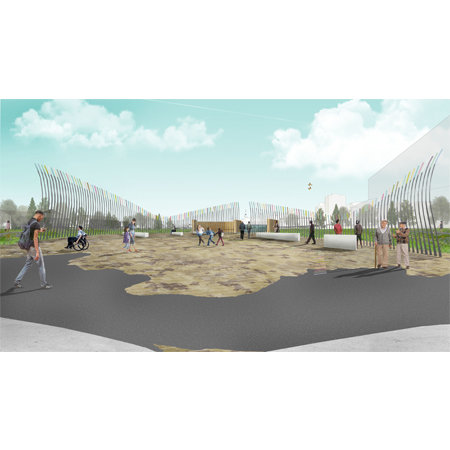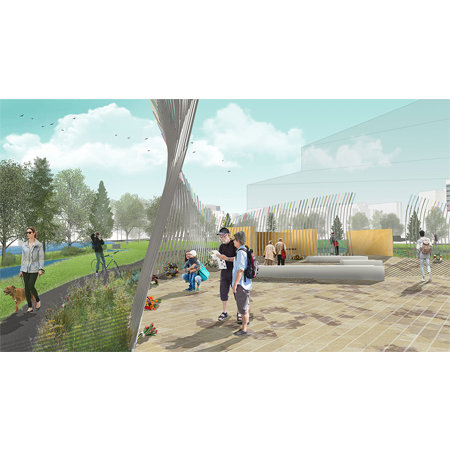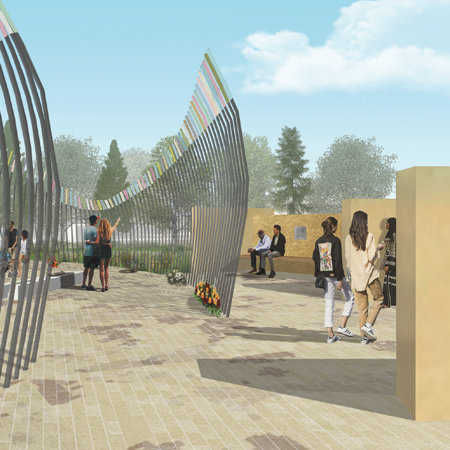Team Lashley + JMA is proud to submit its concept for the National Monument for Canada’s Mission in Afghanistan, as one of five finalist teams in this national competition. The design can be viewed online, with public input by filling out a short survey. This consultation stage will assist the jury in evaluating the proposals.
To review the finalists' designs, visit the Government of Canada Design Competition website.

View within Monument Plaza
The core team, of David Lashley (Ottawa • Montreal), John MacDonald (Kitchener), and Sandra Dunn (Kitchener), has worked these last months to design a monument that honours those who served. It supports meaningful discussion and thoughtful contemplation of Canada's role in our World, and the Mission’s complex legacy for Canada, for participants, and for Afghanistan.
The Monument draws on the concept of “Shura”, a traditional gathering of elders for the purpose of local or national conflict resolution and decision by consensus. Canadian Military engaged in shuras in an effort to move beyond our security role, to a place of stability where lasting progress could be made. These face-to-face meetings were a highly effective way to communicate Canada's efforts to help, to create mutual bonds of trust and respect, and to gauge local perceptions of our foreign presence.
The Monument has three main components: a semi-circular Plaza, a delicate but robust sweep of Wings, and five commemorative Plinths. These elements form and interact with a carefully designed landscape setting.
The Plaza's richly textured surface is inspired by the CADPAT-AR camouflage pattern of the Canadian military uniforms. It embodies both the complex and shifting landscape of the Mission, and the Canadian network of diplomats, aid workers and other civilian government officials who, with the military, engaged in the monumental effort to turn a landscape of conflict into one of hope.
The Wings are meant to capture a moment when potential is converted into action and possibility. They are formed from 165 vertical steel blades tipped with cast glass. They complete the design's principal gathering space, and they honour the Canadians who gave their lives. Visitors will be keenly aware as they stand shoulder to shoulder with those who sacrificed so much, and they participate in shaping the ongoing dialogue regarding the significance of Canada's largest and most comprehensive international development mission.

Close up View of Plaza - Wings, Gathering & Landscape
The Plinths commemorate the major groups of extraordinary Canadians who performed noble tasks to the highest standards of their professions and under very difficult circumstances. Brass words cast into concrete suggest not only values, but honest dialogue about the realities of the situation in Afghanistan.
The Plaza's richly textured surface is inspired by the CADPAT-AR camouflage pattern of the Canadian military uniforms. It embodies both the complex and shifting landscape of the Mission, and the Canadian network of diplomats, aid workers and other civilian government officials who, with the military, engaged in the monumental effort to turn a landscape of conflict into one of hope.
The composition’s Landscape punctuates the urban and memorial style of the National Capital’s LeBreton Flats Booth Street corridor evoking memories of the textures and colours of Afghan meadows, plains, trees and hills. It portrays the stark simplicity of the Afghan countryside and stone buildings memorializing the place of the Mission.
In reflecting upon the team's journey thus far, John MacDonald says: “Our collaboration and intense design research in these past months have greatly enriched us. We've tried to place ourselves within the Mission and with its participants and their families. Our design reflects this journey and portrays both the complexity of the Mission and the values for which Canadians strive and sacrifice, as we move beyond conflict to reconciliation and hope.”
The team membership includes:
Sandra Dunn, visual artist and blacksmith, and her team at Two Smiths, based in Kitchener, ON;
John MacDonald and staff at John MacDonald Architect, an architectural design studio based in the Grand River Watershed at Kitchener, ON;
David Lashley and senior staff at Lashley + Associates, a landscape architecture firm based in the National Capital Region at Ottawa, ON and in Montreal, QC;
Gabriel Mackinnon Lighting Design, a renowned lighting design firm based in Ottawa as well;
Graeme Smith, Canadian journalist and author;
Bram Porter, a veteran of the Mission and collaborator at Sandra's Two Smiths studio;
the structural division of MTE Consultants, of Kitchener, ON;
the Ottawa offices of
Marshall & Murray, cost consultants;
Parsons, specifically its Ottawa civil design office; and
VanderWesten & Rutherford Consulting Engineers, and its Ottawa electrical engineering group.

Place of Personal Reflection



